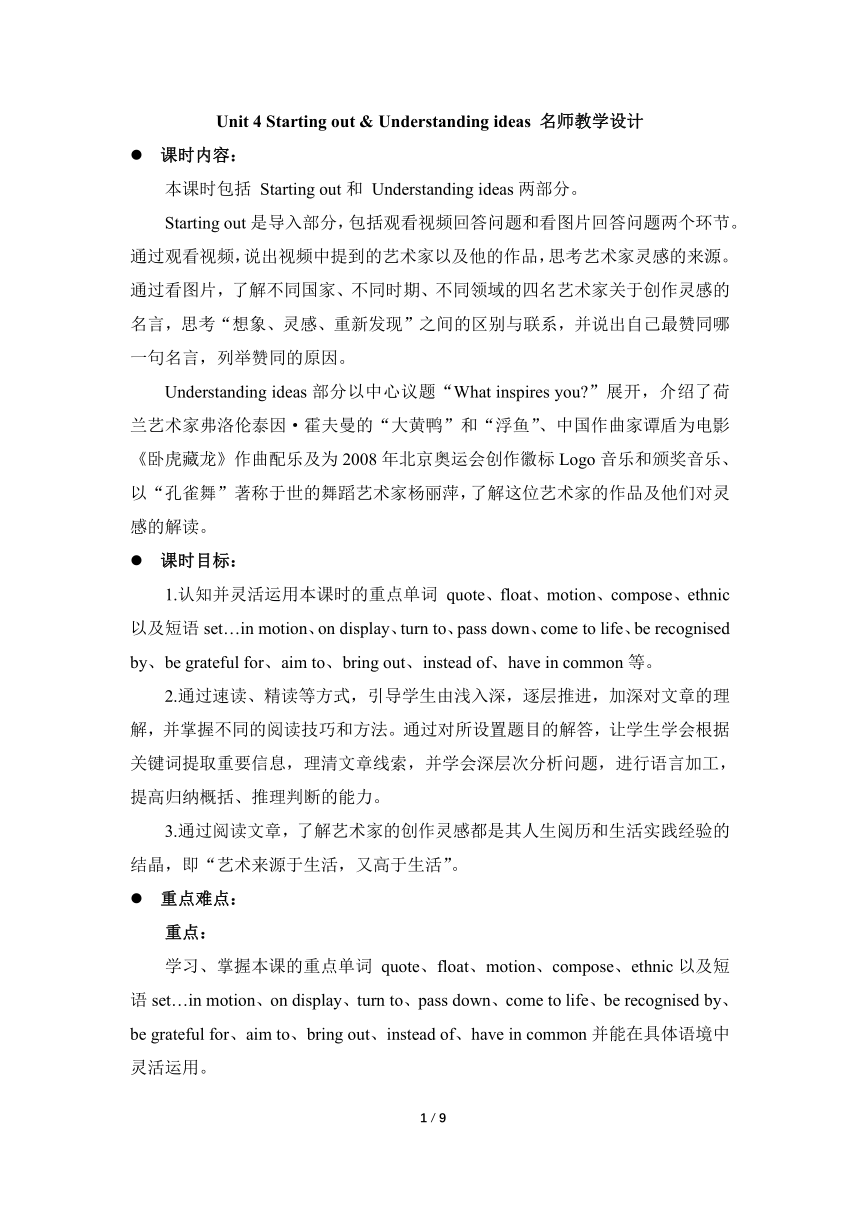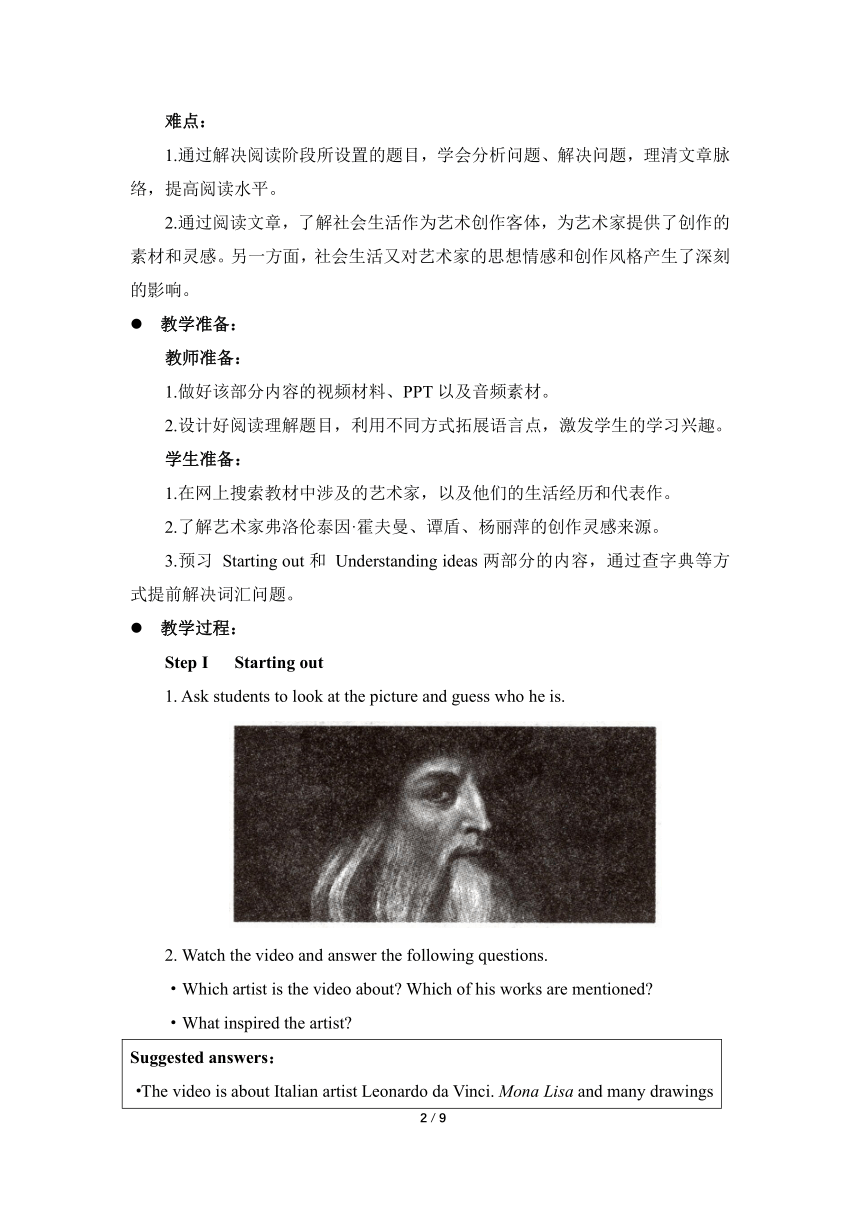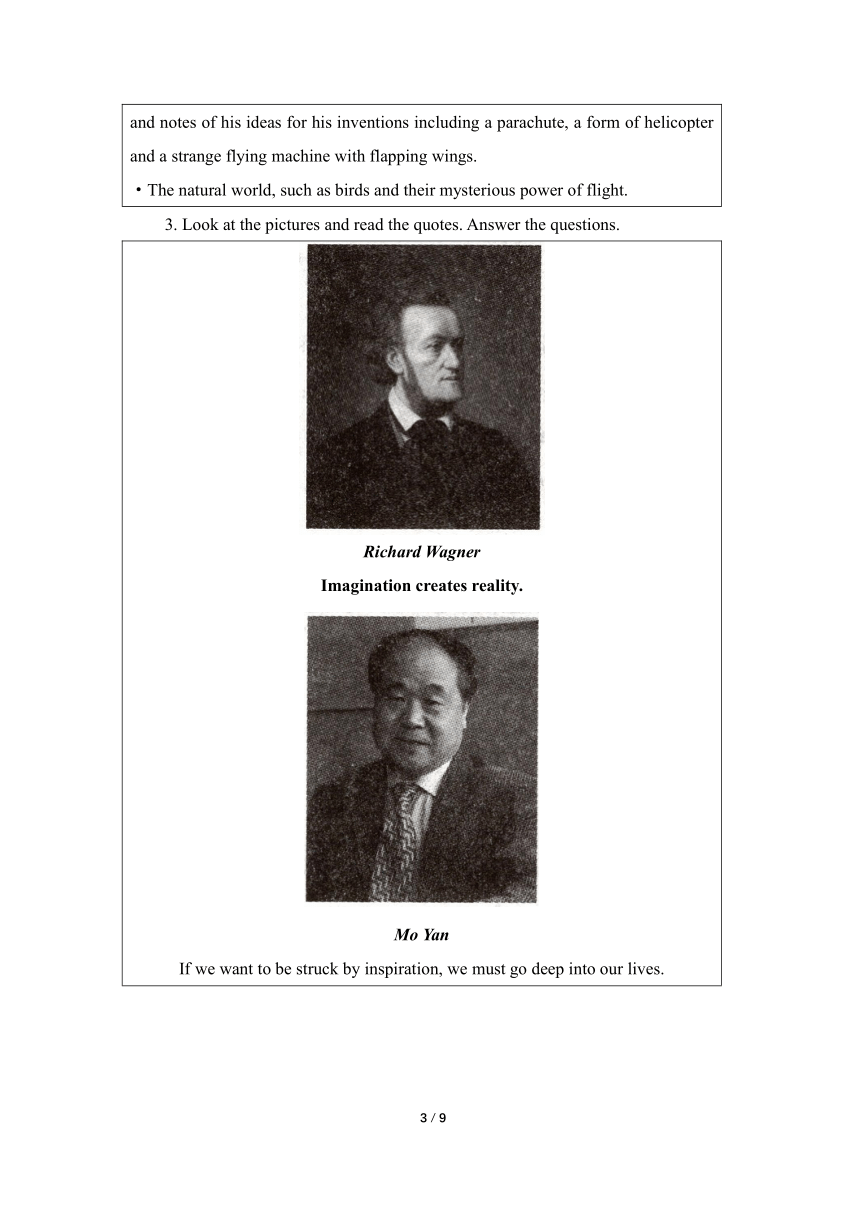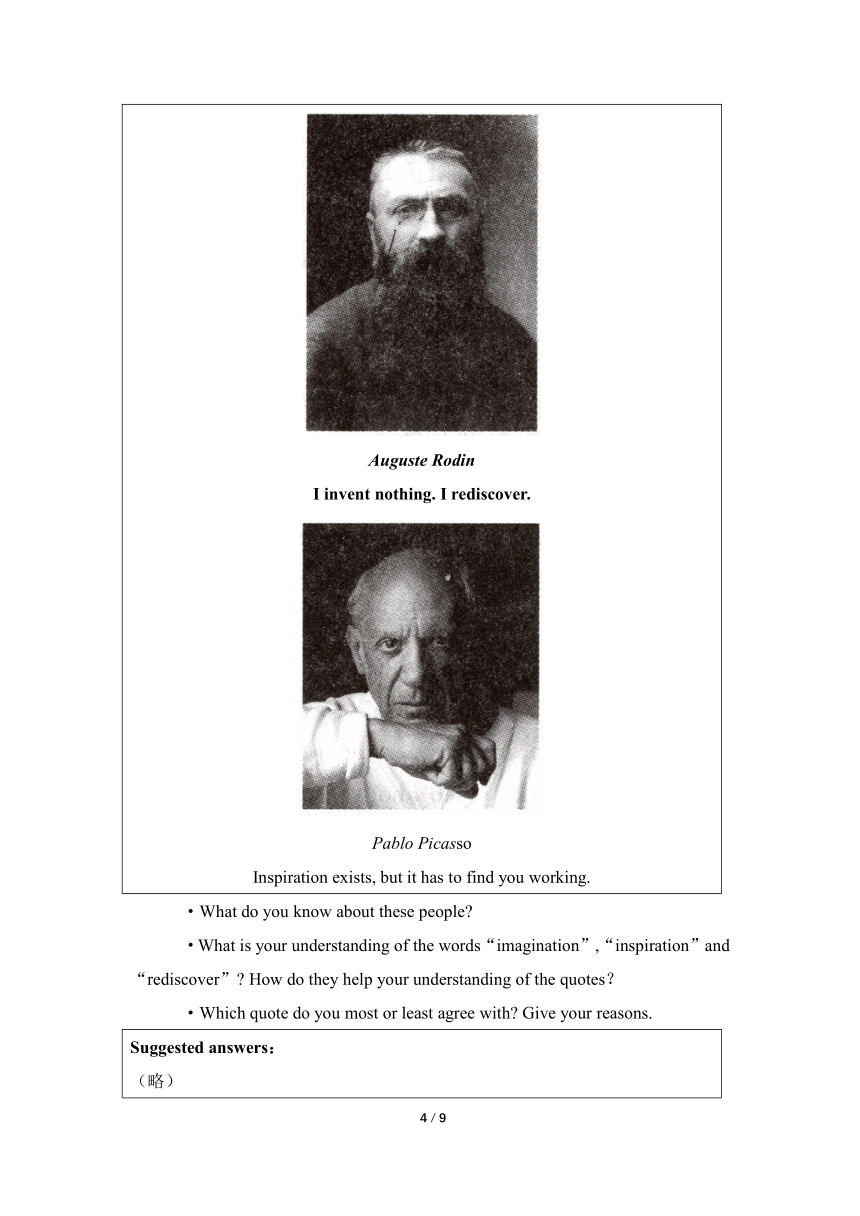外研版(2019)选择性必修 第一册Unit 4 Meeting the muse Starting out and Understanding ideas 名师教学设计
文档属性
| 名称 | 外研版(2019)选择性必修 第一册Unit 4 Meeting the muse Starting out and Understanding ideas 名师教学设计 |  | |
| 格式 | docx | ||
| 文件大小 | 4.3MB | ||
| 资源类型 | 教案 | ||
| 版本资源 | 外研版(2019) | ||
| 科目 | 英语 | ||
| 更新时间 | 2023-03-02 17:09:19 | ||
图片预览




文档简介
Unit 4 Starting out & Understanding ideas 名师教学设计
课时内容:
本课时包括 Starting out和 Understanding ideas两部分。
Starting out是导入部分,包括观看视频回答问题和看图片回答问题两个环节。通过观看视频,说出视频中提到的艺术家以及他的作品,思考艺术家灵感的来源。通过看图片,了解不同国家、不同时期、不同领域的四名艺术家关于创作灵感的名言,思考“想象、灵感、重新发现”之间的区别与联系,并说出自己最赞同哪一句名言,列举赞同的原因。
Understanding ideas部分以中心议题“What inspires you ”展开,介绍了荷兰艺术家弗洛伦泰因·霍夫曼的“大黄鸭”和“浮鱼”、中国作曲家谭盾为电影《卧虎藏龙》作曲配乐及为2008年北京奥运会创作徽标Logo音乐和颁奖音乐、以“孔雀舞”著称于世的舞蹈艺术家杨丽萍,了解这位艺术家的作品及他们对灵感的解读。
课时目标:
1.认知并灵活运用本课时的重点单词 quote、float、motion、compose、ethnic以及短语set…in motion、on display、turn to、pass down、come to life、be recognised by、be grateful for、aim to、bring out、instead of、have in common等。
2.通过速读、精读等方式,引导学生由浅入深,逐层推进,加深对文章的理解,并掌握不同的阅读技巧和方法。通过对所设置题目的解答,让学生学会根据关键词提取重要信息,理清文章线索,并学会深层次分析问题,进行语言加工,提高归纳概括、推理判断的能力。
3.通过阅读文章,了解艺术家的创作灵感都是其人生阅历和生活实践经验的结晶,即“艺术来源于生活,又高于生活”。
重点难点:
重点:
学习、掌握本课的重点单词 quote、float、motion、compose、ethnic以及短语set…in motion、on display、turn to、pass down、come to life、be recognised by、be grateful for、aim to、bring out、instead of、have in common并能在具体语境中灵活运用。
难点:
1.通过解决阅读阶段所设置的题目,学会分析问题、解决问题,理清文章脉络,提高阅读水平。
2.通过阅读文章,了解社会生活作为艺术创作客体,为艺术家提供了创作的素材和灵感。另一方面,社会生活又对艺术家的思想情感和创作风格产生了深刻的影响。
教学准备:
教师准备:
1.做好该部分内容的视频材料、PPT以及音频素材。
2.设计好阅读理解题目,利用不同方式拓展语言点,激发学生的学习兴趣。
学生准备:
1.在网上搜索教材中涉及的艺术家,以及他们的生活经历和代表作。
2.了解艺术家弗洛伦泰因·霍夫曼、谭盾、杨丽萍的创作灵感来源。
3.预习 Starting out和 Understanding ideas两部分的内容,通过查字典等方式提前解决词汇问题。
教学过程:
Step I Starting out
1. Ask students to look at the picture and guess who he is.
2. Watch the video and answer the following questions.
·Which artist is the video about Which of his works are mentioned
·What inspired the artist
Suggested answers: ·The video is about Italian artist Leonardo da Vinci. Mona Lisa and many drawings and notes of his ideas for his inventions including a parachute, a form of helicopter and a strange flying machine with flapping wings. ·The natural world, such as birds and their mysterious power of flight.
3. Look at the pictures and read the quotes. Answer the questions.
Richard Wagner Imagination creates reality. Mo Yan If we want to be struck by inspiration, we must go deep into our lives. Auguste Rodin I invent nothing. I rediscover. Pablo Picasso Inspiration exists, but it has to find you working.
·What do you know about these people
·What is your understanding of the words“imagination”,“inspiration”and“rediscover” How do they help your understanding of the quotes?
·Which quote do you most or least agree with Give your reasons.
Suggested answers: (略)
4.Ask students to collect some information about artists and inspiration. Then share the information with the class.
【设计意图】通过观看视频和看图片,让学生初步了解本单元内容,为接下来的学习做铺垫。
Step II Reading
1. Pre-reading.
Do Activity 1 on Page 38.
(1) Tick what you think are the most important sources of inspiration for artists.
□childhood □family and friends
□books and films □other artists
□history □travel
□nature □Social issues
□private feelings □culture and traditions
□imagination
(2) Work in pairs to compare and explain your choices.
2. Fast reading.
Read the passage quickly and choose the best answers.
①What is the inspiration of Rubber Duck related to A. Childhood amusement. B. Travelling experience. C. Chinese folk tales. D. His imagination. ②Which of the following is not related to Tan Dun’s works A. Nine songs. B Crouching Tiger, Hidden dragon. C. 2008 Beijing Olympics. D. Spirit of the Peacock dance. ③What feature does Tan Dun’s music have A. Pure Chinese style. B. Street music. C. Combining tradition with other styles. D. Popular native Chinese music. ④Why is Yang Liping known as the“Peacock Princess” A. Because she has graceful behaviours. B. Because she won an award with peacock dance. C. Because she spent much time staying with peacock. D. Because her inspiration comes from peacock.
Suggested answers: ①—④ ADCB
【设计意图】通过选择题环节,进一步锻炼学生回扣原文,提取关键信息的能力。
3.Careful reading.
(1)Language points.
Master the words and phrases:
quote,float,motion,compose,ethnic,set...in motion,on display,turn to,pass down,come to life,be recognised by,be grateful for,aim to,bring out,instead of,have in common
【备注】词汇知识点讲解详见第二教案“新知探究”。
(2)Read the passage again and retell it.
【设计意图】通过复述课文,进一步归纳、概括文章,理清文章脉络,有助于学生加深对文章的理解,同时,在读懂语篇的基础上,将英语语法、句法、词汇的知识融合在一起,该活动能够科学地反映学生的口头表达能力和英语综合水平。
4.Post-reading.
(1) Do Activity 3 on Page 40.
Choose where you would most likely find the passage and give your reasons.
① An art magazine.
② An artist biography.
③ An online art forum.
④ A poster for an art festival.
Suggested answers: ①
【设计意图】以选择题的形式呈现,让学生选出文章的出处,提升学生的推理判断能力。
(2)Do Activity 4 on Page 40.
Organise information from the passage and complete the diagram.
Suggested answers: ①Floating Fish ②Chinese folk tales ③Wuzhen and the way people lived there ④composing music for the film Crouching Tiger,Hidden dragon and the 2008 Beijing Olympics ⑤Nine songs ⑥Chinese musical traditions ⑦Spirit of the Peacock ⑧the peacock ⑨the dance style of the Dai people
【设计意图】通过表格的形式概述了三位伟大艺术家的主要信息,包括代表作以及灵感来源。教师可引导学生抓住题目中的关键词,通过原文定位法,找到问题的答案。
Step Ⅲ Summing up
1.总结本节课的重点单词 quote、float、motion、compose、ethnic以及短语set…in motion、on display、turn to、pass down、come to life、be recognised by、be grateful for、aim to、bring out、instead of、have in common和句型,采用表格、思维导图等形式更清晰地了解它们的用法,形成知识脉络。
2.让学生用简短的英语陈述三位艺术家的代表作以及创作灵感的来源,进一步锻炼学生概括、归纳的能力
3.引导学生学习艺术家们深入生活、细心观察的创作精神。
Step IV Homework
1. Sum up what you learned in class and take notes.
2. Preview the next period.
板书设计
Unit 4 Meeting the muse Period I Starting out & Understanding ideas I. Starting out 1. Ask students to look at the picture and guess who he is. 2. Watch the video and answer the questions. ·Which artist is the video about Which of his works are mentioned ·What inspired the artist 3. Look at the pictures and read the quotes. Answer the questions. ·What do you know about these people ·What is your understanding of the words“Imagination”,“Inspiration”and”“rediscover” How do they help your understanding of the quotes ·Which quote do you most or least agree with Give your reasons. 4. Ask students to collect some information about artists and inspiration. Then share the information with the class. Ⅱ. Reading 1. Pre-reading. Do Activity 1 on Page 38. 2. Fast reading. Read the passage quickly and choose the best answers. 3. Careful reading. (1) Language points. (2) Read the passage again and retell it. 4. Post-reading. Do Activities 3&4 on Page 40. Ⅲ. Summing up Ⅳ. Homework
1 / 9
课时内容:
本课时包括 Starting out和 Understanding ideas两部分。
Starting out是导入部分,包括观看视频回答问题和看图片回答问题两个环节。通过观看视频,说出视频中提到的艺术家以及他的作品,思考艺术家灵感的来源。通过看图片,了解不同国家、不同时期、不同领域的四名艺术家关于创作灵感的名言,思考“想象、灵感、重新发现”之间的区别与联系,并说出自己最赞同哪一句名言,列举赞同的原因。
Understanding ideas部分以中心议题“What inspires you ”展开,介绍了荷兰艺术家弗洛伦泰因·霍夫曼的“大黄鸭”和“浮鱼”、中国作曲家谭盾为电影《卧虎藏龙》作曲配乐及为2008年北京奥运会创作徽标Logo音乐和颁奖音乐、以“孔雀舞”著称于世的舞蹈艺术家杨丽萍,了解这位艺术家的作品及他们对灵感的解读。
课时目标:
1.认知并灵活运用本课时的重点单词 quote、float、motion、compose、ethnic以及短语set…in motion、on display、turn to、pass down、come to life、be recognised by、be grateful for、aim to、bring out、instead of、have in common等。
2.通过速读、精读等方式,引导学生由浅入深,逐层推进,加深对文章的理解,并掌握不同的阅读技巧和方法。通过对所设置题目的解答,让学生学会根据关键词提取重要信息,理清文章线索,并学会深层次分析问题,进行语言加工,提高归纳概括、推理判断的能力。
3.通过阅读文章,了解艺术家的创作灵感都是其人生阅历和生活实践经验的结晶,即“艺术来源于生活,又高于生活”。
重点难点:
重点:
学习、掌握本课的重点单词 quote、float、motion、compose、ethnic以及短语set…in motion、on display、turn to、pass down、come to life、be recognised by、be grateful for、aim to、bring out、instead of、have in common并能在具体语境中灵活运用。
难点:
1.通过解决阅读阶段所设置的题目,学会分析问题、解决问题,理清文章脉络,提高阅读水平。
2.通过阅读文章,了解社会生活作为艺术创作客体,为艺术家提供了创作的素材和灵感。另一方面,社会生活又对艺术家的思想情感和创作风格产生了深刻的影响。
教学准备:
教师准备:
1.做好该部分内容的视频材料、PPT以及音频素材。
2.设计好阅读理解题目,利用不同方式拓展语言点,激发学生的学习兴趣。
学生准备:
1.在网上搜索教材中涉及的艺术家,以及他们的生活经历和代表作。
2.了解艺术家弗洛伦泰因·霍夫曼、谭盾、杨丽萍的创作灵感来源。
3.预习 Starting out和 Understanding ideas两部分的内容,通过查字典等方式提前解决词汇问题。
教学过程:
Step I Starting out
1. Ask students to look at the picture and guess who he is.
2. Watch the video and answer the following questions.
·Which artist is the video about Which of his works are mentioned
·What inspired the artist
Suggested answers: ·The video is about Italian artist Leonardo da Vinci. Mona Lisa and many drawings and notes of his ideas for his inventions including a parachute, a form of helicopter and a strange flying machine with flapping wings. ·The natural world, such as birds and their mysterious power of flight.
3. Look at the pictures and read the quotes. Answer the questions.
Richard Wagner Imagination creates reality. Mo Yan If we want to be struck by inspiration, we must go deep into our lives. Auguste Rodin I invent nothing. I rediscover. Pablo Picasso Inspiration exists, but it has to find you working.
·What do you know about these people
·What is your understanding of the words“imagination”,“inspiration”and“rediscover” How do they help your understanding of the quotes?
·Which quote do you most or least agree with Give your reasons.
Suggested answers: (略)
4.Ask students to collect some information about artists and inspiration. Then share the information with the class.
【设计意图】通过观看视频和看图片,让学生初步了解本单元内容,为接下来的学习做铺垫。
Step II Reading
1. Pre-reading.
Do Activity 1 on Page 38.
(1) Tick what you think are the most important sources of inspiration for artists.
□childhood □family and friends
□books and films □other artists
□history □travel
□nature □Social issues
□private feelings □culture and traditions
□imagination
(2) Work in pairs to compare and explain your choices.
2. Fast reading.
Read the passage quickly and choose the best answers.
①What is the inspiration of Rubber Duck related to A. Childhood amusement. B. Travelling experience. C. Chinese folk tales. D. His imagination. ②Which of the following is not related to Tan Dun’s works A. Nine songs. B Crouching Tiger, Hidden dragon. C. 2008 Beijing Olympics. D. Spirit of the Peacock dance. ③What feature does Tan Dun’s music have A. Pure Chinese style. B. Street music. C. Combining tradition with other styles. D. Popular native Chinese music. ④Why is Yang Liping known as the“Peacock Princess” A. Because she has graceful behaviours. B. Because she won an award with peacock dance. C. Because she spent much time staying with peacock. D. Because her inspiration comes from peacock.
Suggested answers: ①—④ ADCB
【设计意图】通过选择题环节,进一步锻炼学生回扣原文,提取关键信息的能力。
3.Careful reading.
(1)Language points.
Master the words and phrases:
quote,float,motion,compose,ethnic,set...in motion,on display,turn to,pass down,come to life,be recognised by,be grateful for,aim to,bring out,instead of,have in common
【备注】词汇知识点讲解详见第二教案“新知探究”。
(2)Read the passage again and retell it.
【设计意图】通过复述课文,进一步归纳、概括文章,理清文章脉络,有助于学生加深对文章的理解,同时,在读懂语篇的基础上,将英语语法、句法、词汇的知识融合在一起,该活动能够科学地反映学生的口头表达能力和英语综合水平。
4.Post-reading.
(1) Do Activity 3 on Page 40.
Choose where you would most likely find the passage and give your reasons.
① An art magazine.
② An artist biography.
③ An online art forum.
④ A poster for an art festival.
Suggested answers: ①
【设计意图】以选择题的形式呈现,让学生选出文章的出处,提升学生的推理判断能力。
(2)Do Activity 4 on Page 40.
Organise information from the passage and complete the diagram.
Suggested answers: ①Floating Fish ②Chinese folk tales ③Wuzhen and the way people lived there ④composing music for the film Crouching Tiger,Hidden dragon and the 2008 Beijing Olympics ⑤Nine songs ⑥Chinese musical traditions ⑦Spirit of the Peacock ⑧the peacock ⑨the dance style of the Dai people
【设计意图】通过表格的形式概述了三位伟大艺术家的主要信息,包括代表作以及灵感来源。教师可引导学生抓住题目中的关键词,通过原文定位法,找到问题的答案。
Step Ⅲ Summing up
1.总结本节课的重点单词 quote、float、motion、compose、ethnic以及短语set…in motion、on display、turn to、pass down、come to life、be recognised by、be grateful for、aim to、bring out、instead of、have in common和句型,采用表格、思维导图等形式更清晰地了解它们的用法,形成知识脉络。
2.让学生用简短的英语陈述三位艺术家的代表作以及创作灵感的来源,进一步锻炼学生概括、归纳的能力
3.引导学生学习艺术家们深入生活、细心观察的创作精神。
Step IV Homework
1. Sum up what you learned in class and take notes.
2. Preview the next period.
板书设计
Unit 4 Meeting the muse Period I Starting out & Understanding ideas I. Starting out 1. Ask students to look at the picture and guess who he is. 2. Watch the video and answer the questions. ·Which artist is the video about Which of his works are mentioned ·What inspired the artist 3. Look at the pictures and read the quotes. Answer the questions. ·What do you know about these people ·What is your understanding of the words“Imagination”,“Inspiration”and”“rediscover” How do they help your understanding of the quotes ·Which quote do you most or least agree with Give your reasons. 4. Ask students to collect some information about artists and inspiration. Then share the information with the class. Ⅱ. Reading 1. Pre-reading. Do Activity 1 on Page 38. 2. Fast reading. Read the passage quickly and choose the best answers. 3. Careful reading. (1) Language points. (2) Read the passage again and retell it. 4. Post-reading. Do Activities 3&4 on Page 40. Ⅲ. Summing up Ⅳ. Homework
1 / 9
